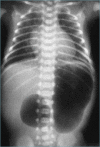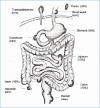Congenital anomalies of the tubular gastrointestinal tract
- PMID: 35212315
- PMCID: PMC9040549
- DOI: 10.32074/1591-951X-553
Congenital anomalies of the tubular gastrointestinal tract
Abstract
Congenital anomalies of the tubular gastrointestinal tract are an important cause of morbidity not only in infants, but also in children and adults.
The gastrointestinal (GI) tract, composed of all three primitive germ layers, develops early during embryogenesis. Two major steps in its development are the formation of the gut tube (giving rise to the foregut, the midgut and the hindgut), and the formation of individual organs with specialized cell types.
Formation of an intact and functioning GI tract is under strict control from various molecular pathways. Disruption of any of these crucial mechanisms involved in the cell-fate decision along the dorsoventral, anteroposterior, left-right and radial axes, can lead to numerous congenital anomalies, most of which occur and present in infancy. However, they may run undetected during childhood.
Therapy is surgical, which in some cases must be performed urgently, and prognosis depends on early diagnosis and suitable treatment.
A precise pathologic macroscopic or microscopic diagnosis is important, not only for the immediate treatment and management of affected individuals, but also for future counselling of the affected individual and their family. This is even more true in cases of multiple anomalies or syndromic patterns.
We discuss some of the more frequent or clinically important congenital anomalies of the tubular GI, including atresia's, duplications, intestinal malrotation, Meckel's diverticulum and Hirschsprung's Disease.
Keywords: Hirschsprung Disease; gastrointestinal malformations; gastrointestinal tract; intestinal atresia; intestinal duplication.
Copyright © 2022 Società Italiana di Anatomia Patologica e Citopatologia Diagnostica, Divisione Italiana della International Academy of Pathology.
Conflict of interest statement
The Authors declare no conflict of interest.
Figures








References
-
- Kostouros A, Koliarakis I, Natsis K, et al. . Large intestine embryogenesis: molecular pathways and related disorders (Review). Int J Mol Med 2020;46:27-57. https://doi.org/10.3892/ijmm.2020.4583 10.3892/ijmm.2020.4583 - DOI - PMC - PubMed
-
- de Santa Barbara P, van den Brink GR, Roberts DJ. Molecular etiology of gut malformations and diseases. Am J Med Genet 2002;115:221-230. https://doi.org/10.1002/ajmg.10978 10.1002/ajmg.10978 - DOI - PubMed
-
- Ioannides AS, Copp AJ. Embryology of oesophageal atresia. Semin Pediatr Surg 2009;18:2-11. https://doi.org/10.1053/j.sempedsurg.2008.10.002 10.1053/j.sempedsurg.2008.10.002 - DOI - PMC - PubMed
-
- van Lennep M, Singendonk MMJ, Dall’Oglio L, et al. . Oesophageal atresia. Nat Rev Dis Primers 2019;5:26. https://doi.org/10.1038/s41572-019-0077-0 10.1038/s41572-019-0077-0 - DOI - PubMed
-
- Kovesi T, Rubin S. Long-term complications of congenital esophageal atresia and/or tracheoesophageal fistula. Chest 2004;126:915-925. https://doi.org/10.1378/chest.126.3.915 10.1378/chest.126.3.915 - DOI - PubMed
Publication types
MeSH terms
LinkOut - more resources
Full Text Sources

